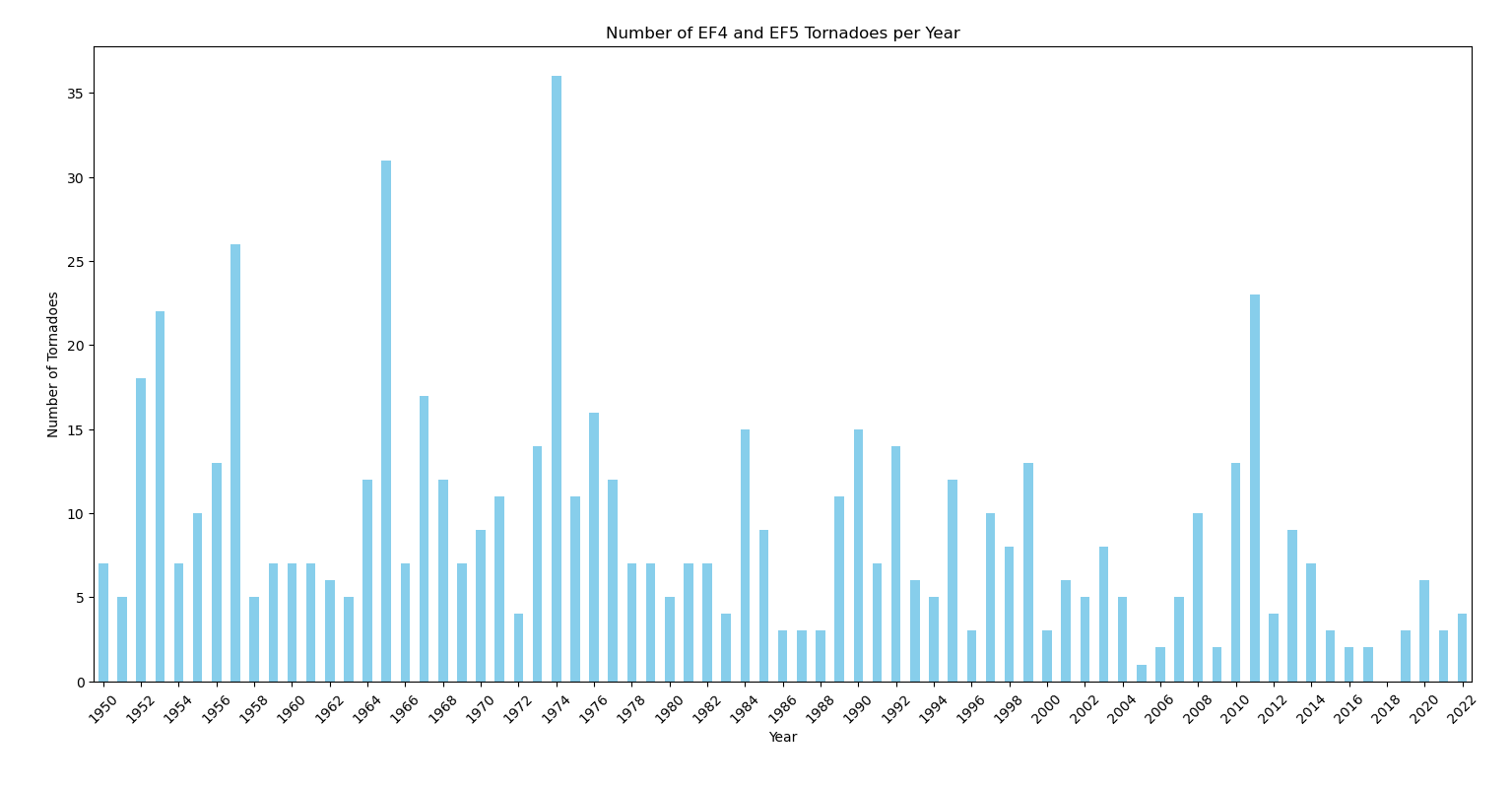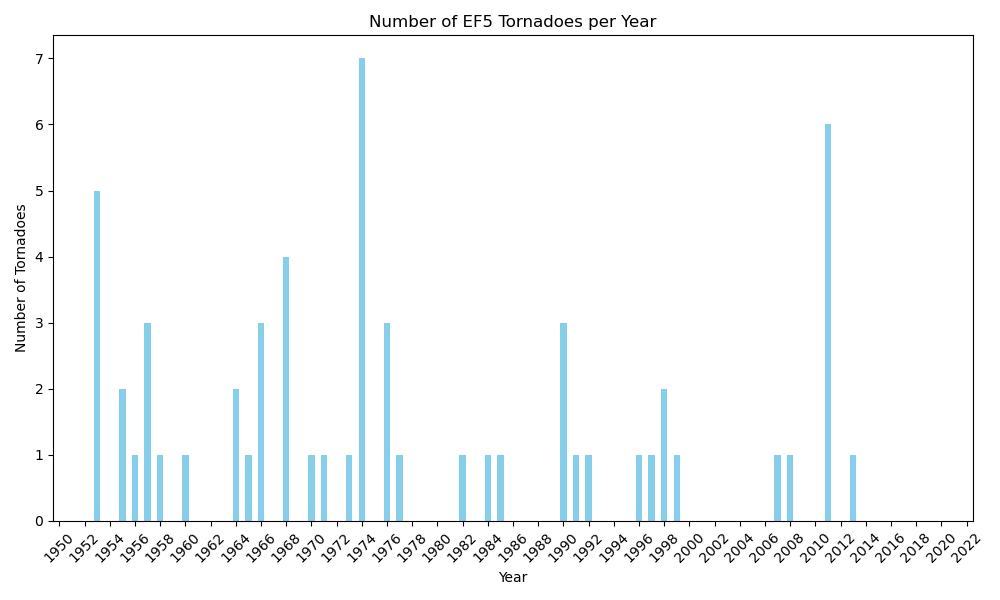EF5 Tornado - Enhanced Fujita Scale
The strongest, and most uncommon tornado is the EF5 on the Enhanced Fujita Scale. Storms producing tornadoes of this strength are exceptionally rare, but they do happen. To be classified as an EF5, wind speeds must reach over 201 mph. It's not unheard of for a tornado to hit winds of 250-300 mph, which is enough to destroy everything in its path. Single family homes are often swept off their concrete foundations, cars are thrown sometimes up to a mile away, and large trees are ripped from the ground and debarked. These tornadoes are among the most violent forces in all of nature.
Just like EF4s, almost all EF5s occur in the United States. Outside of the U.S. and Canada, only seven EF5s have been reported since 1950, five in Europe, one in Argentina, and one in Australia. In comparison, the United States has recorded 59 EF5s within its border since 1950. Only one EF5 has been recorded in Canada. Out of all tornadoes recorded, EF5s make up just .09% in the U.S. and about .05% worldwide. Here’s a map of each EF5 location and track from 1950 to 2019.

You’ll likely notice two distinct hot spots, one in Oklahoma and Kansas, and the other in Mississippi, Alabama, and southern Tennessee. The second hot spot, located in the deep south is commonly known as the “Dixie Alley”. Within Dixie Alley, violent tornadoes often occur earlier in the spring from late February through April, while tornadoes in the Plains and Midwest often occur in May or June. The reason for this seasonality has to do with the position of the jet stream through the year. Violent tornadoes often occur near the jet stream which migrates from the lower latitudes northward as spring progresses. Additionally, EF5s have a higher frequency in the south during El Nino years which is when the equatorial Pacific surface waters are warmer than average. This makes sense given El Nino causes the jet stream to dip over the southern states during winter and early spring.
We understand some of the trends or patterns in violent tornado frequency, but not all of them. For example, the average number of violent tornadoes (EF4 and EF5) appears to be decreasing each year. Here’s a plot of the annual number of violent tornadoes for each year going back to 1950.

The average number of violent tornadoes each year is shrinking, especially in recent times. In fact, there hasn’t been a single EF5 tornado recorded since 2013, over 10 years ago. This is the longest tornado “drought” in recorded history.

The reason why violent tornado activity is diminishing is largely unknown. Climate change is a suspect. It's possible that the decrease is due to the advance in technology and a change in the way we observe tornado intensity.
The last EF5 tornado was recorded on May 20th, 2013, in Moore Oklahoma. The tornado developed during a severe weather outbreak across the central United States, with atmospheric conditions ripe for the formation of violent tornadoes. Touching down near Newcastle, the tornado rapidly intensified as it moved northeastward towards Moore, a suburb of Oklahoma City.
At its peak, the tornado reached a maximum width of over one mile and sustained wind speeds of up to 210 mph (340 km/h), earning it an EF5 rating. The tornado's path through Moore was particularly devastating. Numerous neighborhoods were obliterated, and several schools, including Plaza Towers Elementary School, sustained significant damage. Tragically, seven children lost their lives at Plaza Towers Elementary. In total, 24 fatalities were reported along with 212 injuries.
There has not been a single tornado reported since this event that has been stronger. However, there have been far stronger tornadoes in the past leading up to 2013. In fact, the strongest tornado ever recorded occurred just 14 years earlier on May 3rd, 1999, in almost the same location. This was known as the Bridge Creek-Moore Tornado, which developed due to similar atmospheric conditions as in 2013. A dryline, extending south from Kansas into west Texas, moved east into a warm humid airmass located further east. Convective available potential energy, known as CAPE, was exceptionally high at 4000 J/kg. This signified an extremely instable atmosphere, favorable for severe thunderstorm development. In addition, an extreme amount of shear was in place so when thunderstorms started popping up, tornadoes soon followed.
At around 6:30 pm, a small tornado developed southwest of Oklahoma City. This tornado rapidly intensified, eventually becoming the strongest ever while ravaging through the suburbs of Bridge Creek and Moore. While on its destructive path, a doppler radar measured internal wind speeds of 302 mph +/- 20 mph. This became the highest recorded wind speed on earth. The tornado stayed on the ground for close to an hour and a half, killing 36 and injuring another 583 people. This was the deadliest tornado in Oklahoma history since the 1947 Woodward tornado that took 107 lives.
It is generally accepted that 300 mph is the upper limit in how fast wind speeds can get on Earth. The laws of physics and the current state of our climate largely prohibit anything faster. A tornado needs atmospheric instability, or CAPE, to form and intensify. The more available CAPE, the stronger a tornado can get. But there is a limit on how unstable our atmosphere can get.
This limit is due to the height of our atmosphere and the range of temperatures we experience at the surface and top. The larger the temperature difference between the surface and top of the troposphere (layer of atmosphere where weather occurs), the more energy/instability there is, and thus, the stronger a tornado can become. However, we typically don’t see temperature differences above 200 degrees Fahrenheit, which serves to create a theoretical limit in how strong a tornado can become.
On other planets, such as Jupiter, where the atmosphere is thicker and more unstable, wind speeds can be much faster. For instance, the Great Red Spot on Jupiter's surface has had sustained wind speeds of 400 mph for centuries. Fortunately, events of this magnitude are not possible on Earth, which has allowed life to flourish.
While large, violent tornadoes can and do occur on Earth, they are rare, and the likelihood of encountering one is extremely low. And by having a safety plan, and staying weather aware, your odds of being killed or injured by a tornado become close to zero.